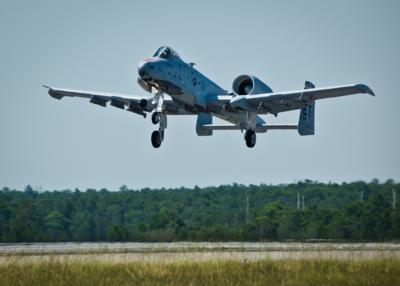Wed, Jul 04, 2012
Airplane 'Flew Like A Usual A-10 Would'
On June 28, the 40th Flight Test Squadron flew the first aircraft to use a new fuel blend derived from alcohol at Eglin Air Force Base in Florida. "The A-10 is the first aircraft ever to fly on this fuel," said Jeff Braun, Chief for the Air Force Alternative Fuel Certification Division, at Wright-Patterson Air Force Base, Ohio. "It flew like a usual A-10 would without any issues," said Maj. Olivia Elliott, an A-10 pilot and an evaluator for the mission.

The fuel, known as ATJ (Alcohol-to-Jet) is the third alternative fuel to be evaluated by the Air Force for fleet-wide use as a replacement for standard petroleum-derived JP-8 aviation fuel. Before ATJ, other alternative fuels included a synthetic paraffinic kerosene derived from coal and natural gas and a bio-mass fuel derived from plant-oils and animal fats known as Hydroprocessed Renewable Jet.
ATJ is a cellulousic-based fuel. It can be derived using wood, paper, grass, anything that is a cell-based material. The sugars extracted from these materials are fermented into alcohols, which are then hydro-processed into the aviation-grade kerosenes used for aviation fuel.
The Fischer-Tropsch SPK blend has been fully certified by the Air Force for operational use throughout the Air Force. All testing of the bio-mass HRJ has been completed and formal coordination is underway to certify it as an approved fuel agent. Like ATJ, the bio-mass fuel was first tested by 40th FLTS in 2010, using the same A-10 test platform.
"The A-10 is an excellent platform for testing the new fuel due in part to its segregated fuel system," said Capt. Joseph Rojas, A-10 test engineer. "The system allows one engine to run off a fuel supply that is completely segregated from the other engine. This allows us to fly with one engine on the new fuel and the other on traditional fuel. If engine operation is normal, as with the ATJ blend, then we progress to flying with both engines on the new fuel."
The A-10 ATJ fuel test went through similar ground and flight tests, using a mixture of the alternative fuel and the standard Air Force JP-8. Ground-based testing included monitoring engine performance and ensuring all data correlated favorably to both the technical requirements and JP-8 fuel specification. Flight tests included analyzing aircraft performance during controlled accelerations and climbs and operational maneuvering.
The Air Force has recently approved fleet-wide certification efforts of the ATJ fuel blend. Once the AFCD completes all air and ground testing, the ATJ will be approved as an official alternative fuel source for Air Force use. "Eventually, it is possible that aircraft will see JP-8 consisting of all these alternatives," said Braun. "You won't be able to determine the difference and you won't care, because all perform as JP-8."
(Photo courtesy USAF)
More News
Aero Linx: Transport Canada We are a federal institution, leading the Transport Canada portfolio and working with our partners. Transport Canada is responsible for transportation p>[...]
Gross Navigation Error (GNE) A lateral deviation from a cleared track, normally in excess of 25 Nautical Miles (NM). More stringent standards (for example, 10NM in some parts of th>[...]
From AirVenture 2017 (YouTube Edition): Flight-Proven Booster On Display At AirVenture… EAA AirVenture Oshkosh is known primarily as a celebration of experimental and amateu>[...]
Aircraft Parachute System (CAPS) Was Deployed About 293 Ft Above Ground Level, Which Was Too Low To Allow For Full Deployment Of The Parachute System Analysis: The day before the a>[...]
Also: 48th Annual Air Race Classic, Hot Air Balloon Fire, FAA v Banning 100LL, Complete Remote Pilot The news Piper PA-18 Super Cub owners have been waiting for has finally arrived>[...]
 ANN's Daily Aero-Linx (06.29.25)
ANN's Daily Aero-Linx (06.29.25) ANN's Daily Aero-Term (06.29.25): Gross Navigation Error (GNE)
ANN's Daily Aero-Term (06.29.25): Gross Navigation Error (GNE) Classic Aero-TV: Anticipating Futurespace - Blue Origin Visits Airventure 2017
Classic Aero-TV: Anticipating Futurespace - Blue Origin Visits Airventure 2017 NTSB Final Report: Cirrus SR22
NTSB Final Report: Cirrus SR22 Airborne Affordable Flyers 06.26.25: PA18 Upgrades, Delta Force, Rhinebeck
Airborne Affordable Flyers 06.26.25: PA18 Upgrades, Delta Force, Rhinebeck



